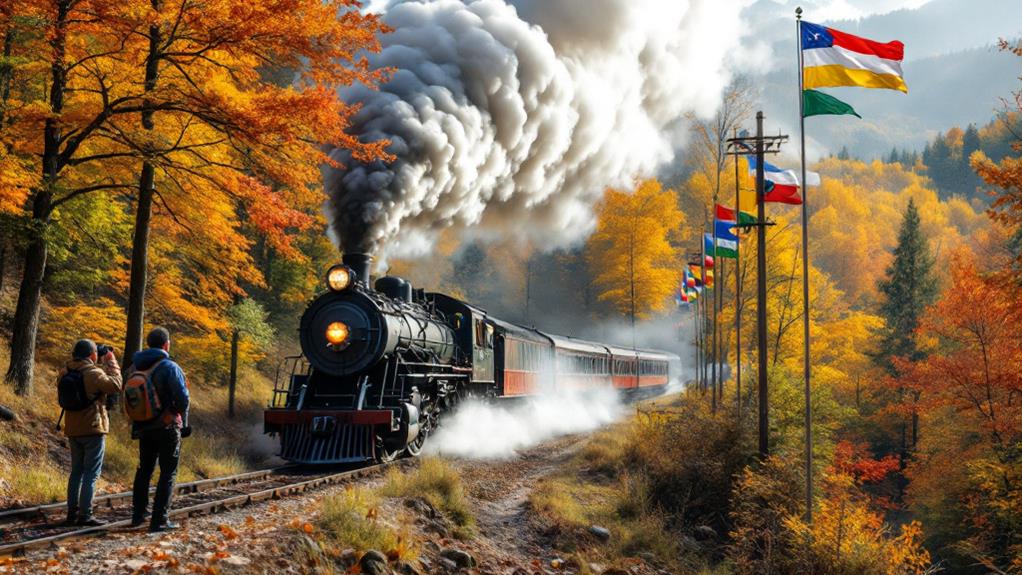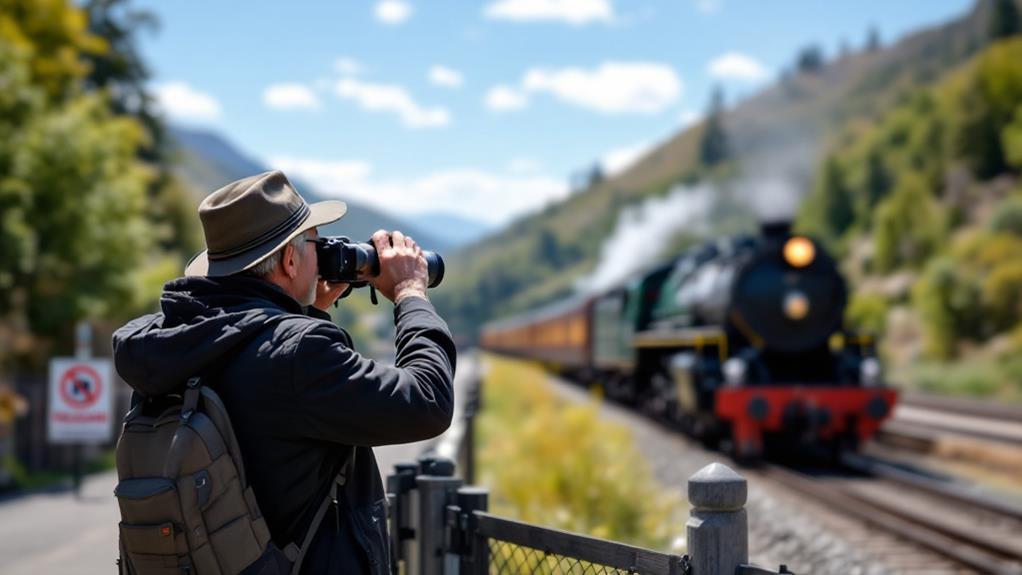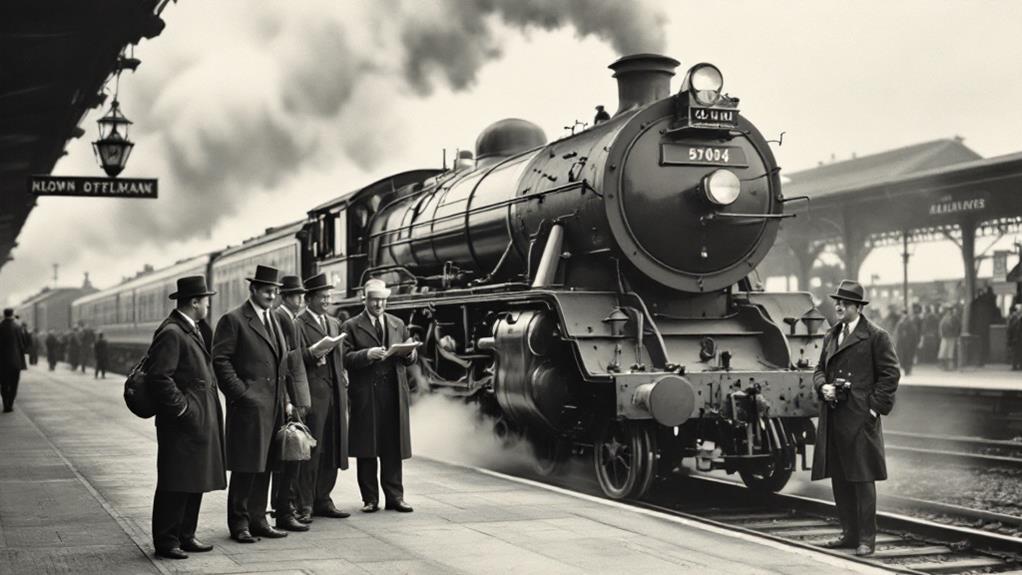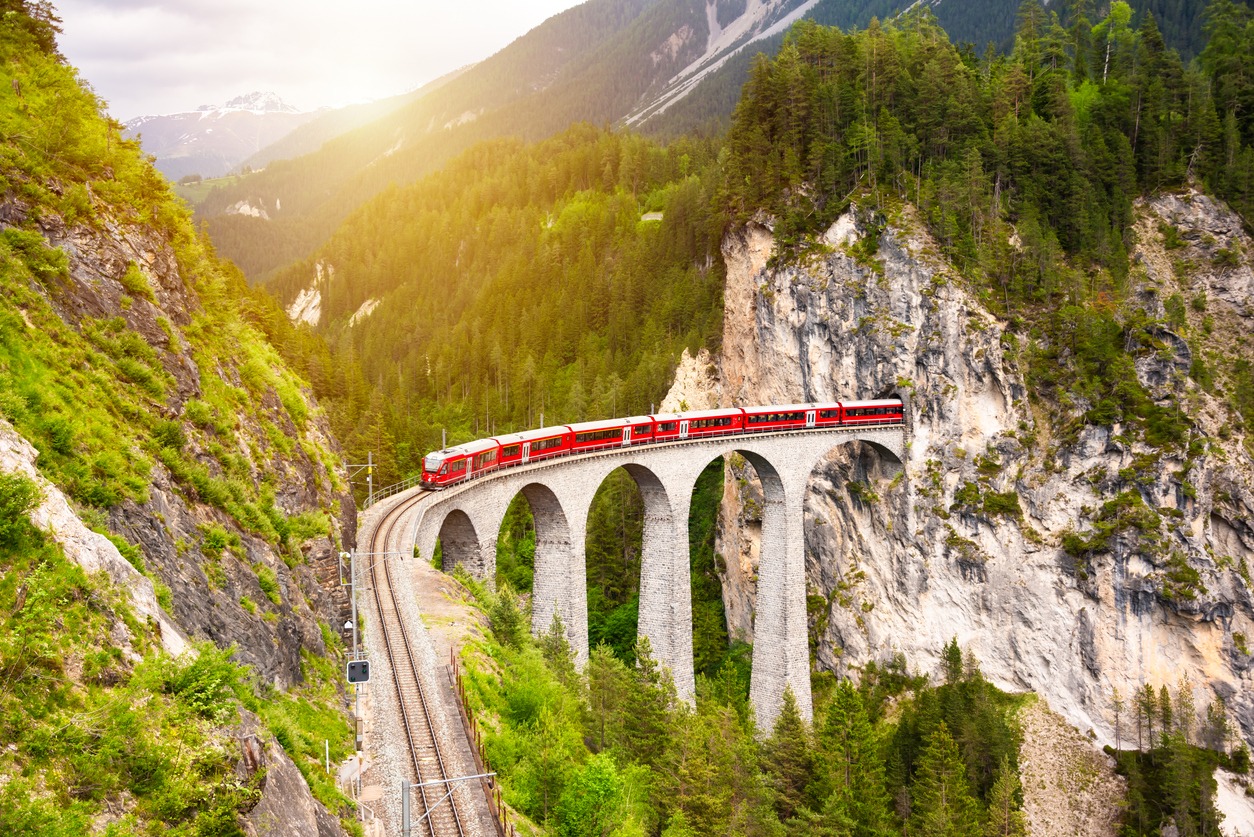Equipment Needed for Trainspotting
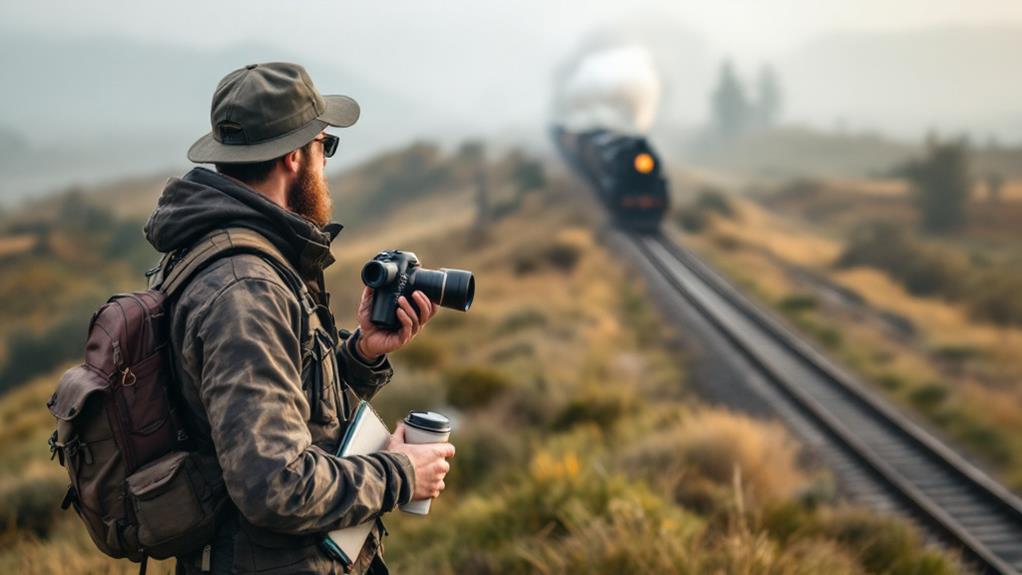
To start trainspotting, you'll need a few key items. Dress in weather-appropriate, high-visibility clothing and sturdy shoes. Bring a notebook, pens, and a camera to record your observations. Don't forget binoculars or a spotting scope for distant trains. Pack reference guides to help identify locomotives and rolling stock. For comfort during long sessions, consider a portable chair and snacks.
Safety is paramount, so stay aware of your surroundings and follow all posted rules. Digital apps can provide real-time train information, while storage solutions help organize your growing collection of trainspotting data. There's much more to investigate in the world of trainspotting equipment.
Essential Clothing for Trainspotting
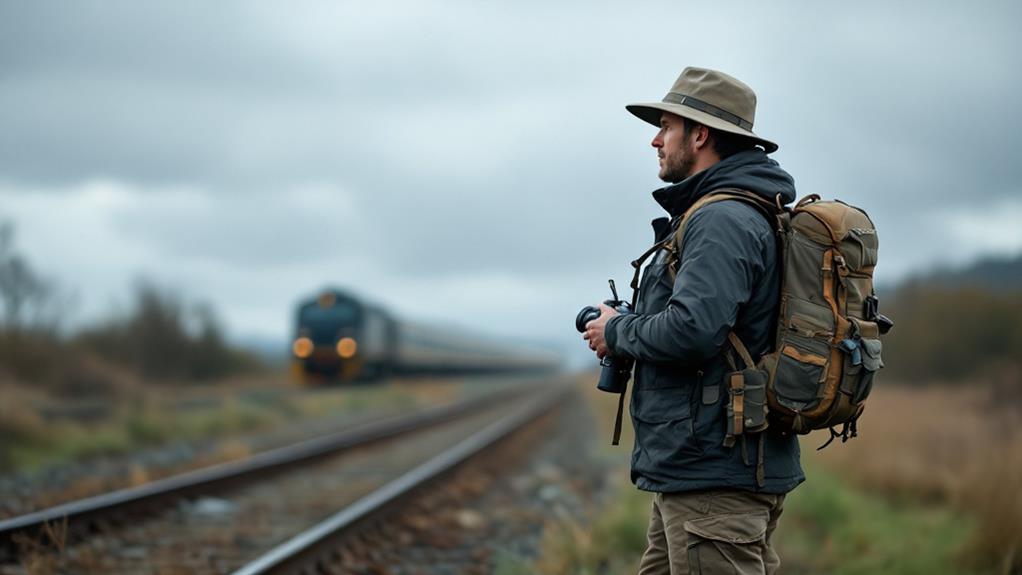
When it comes to trainspotting, what you wear can make or break your experience. Start with a weather-appropriate jacket, such as a waterproof coat, to shield yourself from unexpected rain or wind. This indispensable outer layer will keep you dry and comfortable during extended periods outdoors.
Don't overlook the importance of comfortable shoes. You'll be standing for long stretches, so sturdy footwear is vital for supporting your feet and legs. In colder weather, add gloves, a hat, and a scarf to your ensemble to maintain warmth and prevent discomfort.
Layers of clothing are key to adapting to changing temperatures throughout the day. You can easily add or remove items as needed, ensuring you're always at the right comfort level. Consider wearing bright, high-visibility clothing for safety, especially when trainspotting near active rail lines. This precaution helps railway staff and others spot you easily.
Spotting Guides and Reference Materials
A well-prepared trainspotter never leaves home without the right reference materials. To navigate the vast rail network and accurately identify trains, you'll need thorough trainspotting guides. Platform 5 publications offer detailed TOPS lists, providing essential information on train classes, numbers, and specifications. For a more traditional approach, Bradshaw's Guide remains a popular choice among enthusiasts.
To enhance your trainspotting experience, consider investing in specialized books covering different aspects of rolling stock:
- Locomotive guides to ignite your passion for powerful engines
- Passenger and freight car catalogs to broaden your knowledge
- Regional spotting guides to investigate local rail networks
- Historical references to connect with the rich heritage of railways
You'll find affordable trainspotting guidebooks on platforms like Amazon, perfect for beginners looking to start their collection. As you progress, you may want to explore separate volumes focusing on specific types of rolling stock. Don't forget to check out Ian Allan publications, known for their thorough and accurate information. Remember, having the right reference materials is vital for identifying and documenting your train sightings accurately, making your trainspotting ventures more rewarding and enjoyable.
Writing and Recording Tools
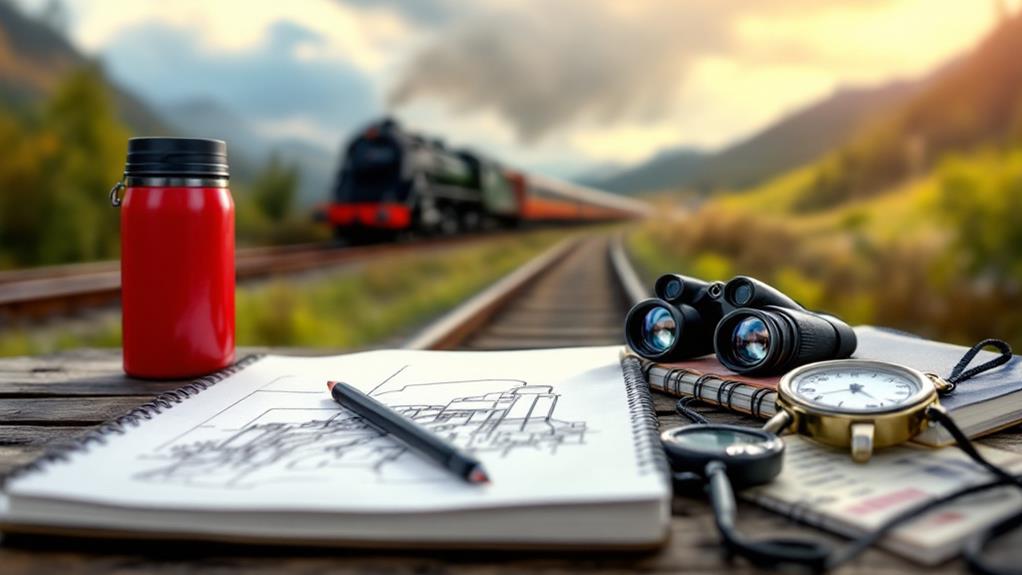
Now that you've got your reference materials sorted, let's focus on the tools you'll need to record your trainspotting observations. A sturdy, ring-bound notebook is essential for jotting down detailed information about the trains you spot. You'll want to use colored pens or pencils to organize your notes and make them easy to read later.
For rail enthusiasts who prefer audio recordings, a portable voice recorder or smartphone app can capture the sounds of passing trains and your spoken observations. These recording tools are particularly useful when you need to quickly document information without taking your eyes off the tracks.
Don't forget your camera! A good zoom lens will help you take photographs of trains from a distance, capturing details of different rail company logos and unique features. Some trainspotters also carry sketchpads and drawing materials to illustrate their sightings, adding a personal touch to their records.
Cameras and Photography Equipment
Photography plays an essential role in modern trainspotting, allowing enthusiasts to capture and share their sightings with precision and artistry. When choosing your camera equipment, you'll want to examine your specific needs and preferences.
DSLR cameras paired with telephoto lenses are the go-to choice for capturing highly detailed train photographs. These setups excel in producing sharp images, even from a distance.
If you're looking for a more portable option, mirrorless cameras offer excellent autofocus and burst shooting capabilities in a compact package.
Don't underestimate the power of smartphone cameras for casual trainspotting. Recent advancements have made them a viable option for capturing quick shots on the go.
To enhance your photography experience, investigate these additional tools:
- Tripods or monopods for stable shots in low light conditions
- Lens filters to add visual impact to your images
- Extra batteries and memory cards for extended outings
- Weather-protective gear to shield your equipment
Binoculars and Optical Aids
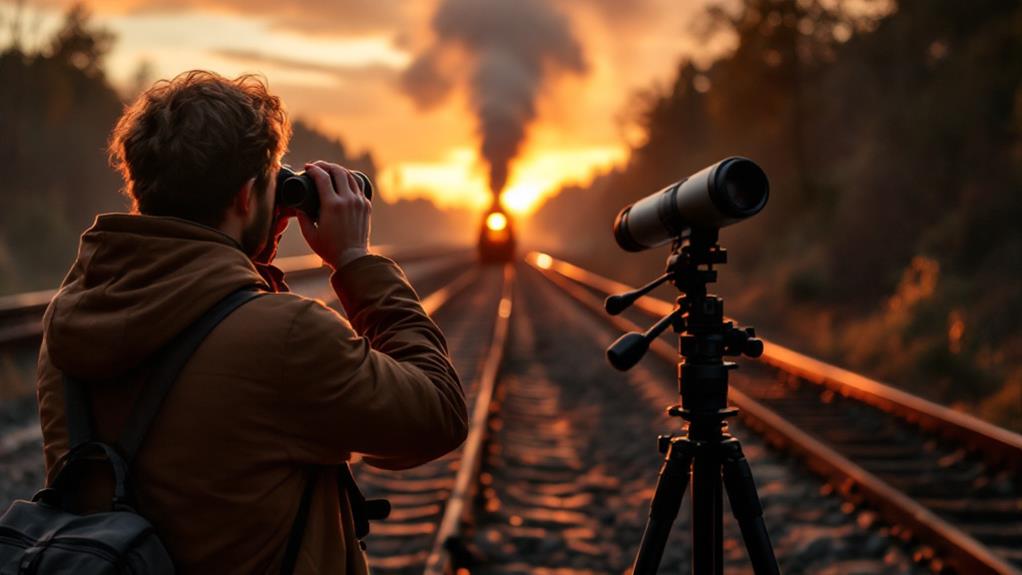
While capturing images is important, seeing trains from afar is equally essential for trainspotters. To achieve this, you'll need high-powered binoculars with at least 10x magnification. These optical aids are fundamental for spotting distant trains and observing their details.
If you're looking for a more portable option, consider lightweight binoculars with image stabilization. These will help you get clear views of fast-moving trains without the shakiness that often comes with handheld viewing. For even more stability and long-distance observation, spotting scopes with tripod mounts are an excellent choice. They'll allow you to set up a stable viewing station and even attach your camera for photography.
Don't overlook the power of digital cameras with strong optical zoom lenses. These can effectively replace binoculars while also allowing you to document your trainspotting experiences. If you prefer a more compact solution, monoculars offer good magnification in a design that's easier to carry and use on the go. Whatever optical aid you choose, make sure it suits your specific trainspotting needs and preferences.
Comfort Items for Long Sessions
During long trainspotting sessions, comfort becomes paramount. As a dedicated railway enthusiast, you'll want to ensure you're well-equipped to handle extended periods of observation. A weatherproof coat is essential for protecting you from the elements, allowing you to focus on spotting different types of trains without worrying about getting wet or cold.
Consider bringing along an umbrella and a portable deckchair for added comfort. These items will help you stay dry and provide a comfortable seat during your extended railway-watching sessions. Train spotters often spend hours waiting for specific trains to pass, so being prepared for long waits is indispensable.
To make your experience more enjoyable and memorable, consider bringing these comfort items:
- A thermos of hot coffee or tea to keep you warm and alert
- Snacks to maintain your energy levels throughout the day
- A portable battery pack to keep your camera and phone charged
- A small cushion or seat pad for added comfort on hard surfaces
Safety Gear and Protective Equipment
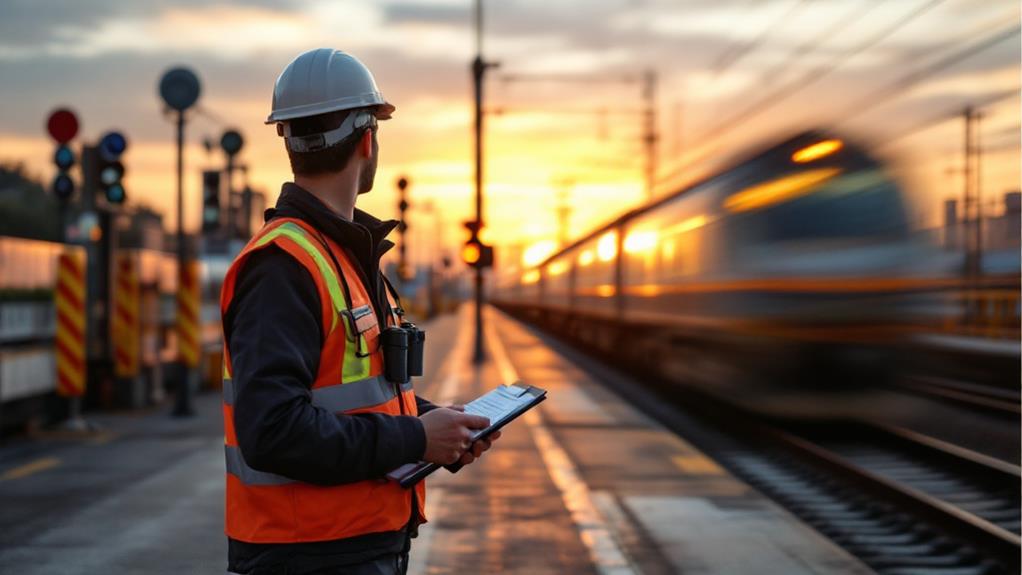
Safety should always be your top priority when trainspotting. To stay safe near the rail, you'll need to equip yourself with the right gear. Start by wearing weatherproof and highly visible clothing to guarantee you're easily seen on the platforms. A high-visibility vest or jacket is essential for train safety and helps prevent accidents.
Don't forget about your footwear. Sturdy, slip-resistant shoes are critical for navigating uneven ground near the tracks. They'll help you maintain your balance and avoid potentially dangerous falls. To further enhance your safety, carry a personal alarm or whistle. These can be lifesavers in emergency situations, allowing you to quickly alert others if you need assistance.
Protect your hearing from the loud noises associated with trains by wearing ear protection, such as noise-cancelling headphones. This will prevent long-term hearing damage while still allowing you to enjoy the trainspotting experience. Remember, trespassing on railway property is illegal and extremely dangerous. Always stay in designated areas and follow all posted safety guidelines. By prioritizing safety and using the right protective equipment, you'll be able to enjoy trainspotting responsibly and securely.
Digital Devices and Apps
In the technological era, trainspotting has evolved to incorporate a range of technological tools. Smartphones with high-quality cameras have become indispensable for capturing stunning train photographs and videos. These devices also allow you to access train timetable and tracking apps, such as National Rail Enquiries, providing real-time information on train movements.
Audio recording devices, like dictaphones, enable you to document your train sightings and observations, preserving the sounds and atmosphere of your trainspotting expeditions. To stay connected with the wider community, you can leverage online forums and social media platforms to share your findings and engage with fellow enthusiasts.
Don't forget to pack a portable power bank to keep your digital devices charged during extended periods trackside. This guarantees you won't miss any pivotal moments or opportunities to document your experiences.
To make the most of your digital trainspotting equipment:
- Capture the thrill of a speeding train with your smartphone's slow-motion video feature
- Share your best shots instantly on social media to inspire other enthusiasts
- Use audio recordings to relive the nostalgic sounds of steam engines
- Connect with trainspotters worldwide through online forums, expanding your knowledge and passion
Weather-Specific Accessories
Trainspotters know that Mother Nature doesn't always cooperate with their plans. That's why weather-specific accessories are vital for enjoying your hobby in any condition. You'll want to start with a waterproof, breathable jacket to shield yourself from rain and wind while waiting on the platform. Don't forget your sturdy, weatherproof boots to keep your feet dry and prevent slipping on uneven ground.
When the temperature drops, well-insulated gloves and a warm hat are essential for staying comfortable as you capture images or jot notes in your platform 5 books. Layered clothing is key, allowing you to adjust to changing weather throughout your trainspotting session. For unexpected showers, an umbrella or portable shelter can provide much-needed cover.
Storage and Organization Solutions
While weather gear safeguards you from the elements, proper storage and organization solutions defend your precious trainspotting data and equipment. Logbooks and binders offer an excellent way to tidily arrange your train sighting records and photographs. You'll find protective sleeves and albums irreplaceable for preserving railway memorabilia like tickets and timetables.
When you're on the move, portable storage containers or backpacks guarantee your trainspotting gear stays safe during transport. For the tech-savvy enthusiast, digital cataloging solutions, such as spreadsheets or specialized apps, provide easy electronic storage and retrieval of your sighting data.
Don't forget about your growing collection of trainspotting resources. Storage boxes or filing cabinets can house larger items like books, magazines, and historical railway documents.
Here's why proper storage and organization are paramount:
- Preserves your memories and hard-earned data for years to come
- Allows quick access to information, enhancing your trainspotting experience
- Protects cherished equipment from damage during transport
- Helps you stay focused on spotting trains instead of wrestling with disorganized materials

